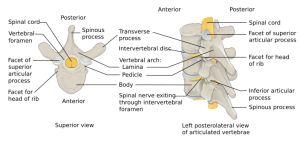Flexion cervical teardrop fracture: Difference between revisions
Neil.m.young (talk | contribs) (Text replacement - "==Diagnosis==" to "==Evaluation==") |
No edit summary |
||
| Line 1: | Line 1: | ||
==Background== | ==Background== | ||
*Is an [[unstable spine fractures|unstable spine injury]] | *Is an [[unstable spine fractures|unstable spine injury]] | ||
{{Vertebral fractures and dislocations types}} | |||
==Clinical Features== | ==Clinical Features== | ||
| Line 11: | Line 13: | ||
==Differential Diagnosis== | ==Differential Diagnosis== | ||
{{ | {{Vertebral fractures and dislocations types}} | ||
==Evaluation== | ==Evaluation== | ||
Revision as of 13:12, 24 October 2020
Background
- Is an unstable spine injury
Vertebral fractures and dislocations types
- Cervical fractures and dislocations
- Thoracic and lumbar fractures and dislocations
Clinical Features
- Severe flexion > vertebral body colliding with the one below (shallow water diving injury, MVC deceleration)
- Most commonly at C5-C6
- Displacement of teardrop shaped fragment of antero-inferior portion of superior vertebra
- Leads to posterior displacement of vertebral body and disruption of posterior longitudinal ligament
- Frequently occurs with spinal cord injury[1]
- Associated with acute anterior cervical cord syndrome
Differential Diagnosis
Vertebral fractures and dislocations types
- Cervical fractures and dislocations
- Thoracic and lumbar fractures and dislocations
Evaluation
- Cervical xrays or CT
Management
Prehospital Immobilization
See NAEMSP National Guidelines for Spinal Immobilization
Hospital
- C-collar
- Consult ortho or spine as needed
Disposition
- Admit
See Also
References
- ↑ Fujimura, Y., Nishi, Y., Chiba, K. and Kobayashi, K. (1995) ‘Prognosis of neurological deficits associated with upper cervical spine injuries’, Spinal Cord, 33(4), pp. 195–202.




